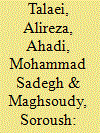| Srl | Item |
| 1 |
ID:
126841


|
|
|
|
|
| Publication |
2014.
|
| Summary/Abstract |
The energy sector is the biggest contributor of anthropogenic emissions of greenhouse gases into the atmosphere in Iran. However, abundant potential for implementing low-carbon technologies offers considerable emissions mitigation potential in this sector, and technology transfer is expected to play an important role in the widespread roll-out of these technologies. In the current work, globally existing low-carbon energy technologies that are compatible with the energy sector of Iran are identified and then prioritised against different criteria (i.e. Multi Criteria Decision Analysis). Results of technology prioritisation and a comprehensive literature review were then applied to conduct a SWOT analysis and develop a policy package aiming at facilitating the transfer of low carbon technologies to the country. Results of technology prioritisation suggest that the transport, oil and gas and electricity sectors are the highest priority sectors from technological needs perspective. In the policy package, while fuel price reform and environmental regulations are categorised as high priority policies, information campaigns and development of human resources are considered to have moderate effects on the process of technology transfer.
|
|
|
|
|
|
|
|
|
|
|
|
|
|
|
|
| 2 |
ID:
167028


|
|
|
|
|
| Summary/Abstract |
The optimization of spatial planning in order to identify the most suitable places for the installation of wind farms is one of the most difficult problems mainly due to the need of identification and calculation of a variety of qualitative and quantitative parameters as well as their effect on the final solution. Multi Criteria Decision Making Methods (MCDM) are commonly used in order to solve this problem and are combined with Geographic Information Systems (GIS) to spatially represent the results from the application of the MCDM methodology. This paper presents a methodology which is based on the combination of a MCDM methodology called Analytical Hierarch Process (AHP) and GIS in order to determine the most suitable locations for wind farms installation. The calculated locations are then ranked using the Technique for Order Preference by Similarity to Ideal Solution (TOPSIS) in order to rank the locations based on installation suitability. The application of this methodology can help decision makers to easily overcome conflicting parameters and propose optimal solutions which are acceptable from citizens and stake holders while at the same time are economical and environmental friendly.
|
|
|
|
|
|
|
|
|
|
|
|
|
|
|
|
| 3 |
ID:
141874


|
|
|
|
|
| Summary/Abstract |
Main battle tanks (MBTs) have always been in the heart of all military campaigns and have enabled armies to fight across the full spectrum of war. Countries need to consider the complex interactions between subsystems of MBTs in the decision phase of a design process or MBT acquisition. In order to define the interaction among the subsystems of ‘system of systems’, which is MBT system for this case, this study aims to determine the criteria and their sub criteria affecting MBT selection problem and to analyse the cause and effect relations among these criteria. The criteria and the complex interaction among them have been determined by consulting a group of experts. Because of multiple complex criteria interactions in MBT selection problem, decision making trial and evaluation laboratory (DEMATEL) method is used as a multiple criteria decision making method. DEMATEL method is applied on the main and the sub criteria separately to understand the cause and effect relations. The results show that Survivability main criterion has the strongest central role among the main criteria for MBT selection, while the followers are firepower, mobility and command and control (C2). It is also shown that, in terms of sub criteria for MBT selection, ballistic protection, a sub criterion of survivability main criterion, has the highest degree of influence over most of the other sub criteria. However, physical dimensions/silhouette, another sub criterion of survivability, is the most affected sub criteria. The top five sub criteria in terms of central role are determined as physical dimensions/silhouette, ballistic protection, power/weight ratio, ground pressure and suspension system.
|
|
|
|
|
|
|
|
|
|
|
|
|
|
|
|